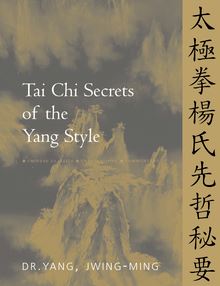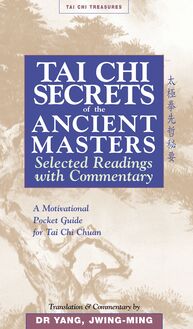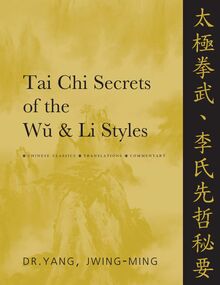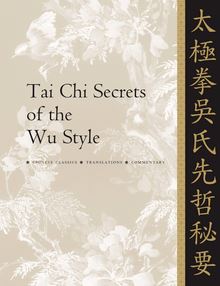-
 Univers
Univers
-
 Ebooks
Ebooks
-
 Livres audio
Livres audio
-
 Presse
Presse
-
 Podcasts
Podcasts
-
 BD
BD
-
 Documents
Documents
-
- Cours
- Révisions
- Ressources pédagogiques
- Sciences de l’éducation
- Manuels scolaires
- Langues
- Travaux de classe
- Annales de BEP
- Etudes supérieures
- Maternelle et primaire
- Fiches de lecture
- Orientation scolaire
- Méthodologie
- Corrigés de devoir
- Annales d’examens et concours
- Annales du bac
- Annales du brevet
- Rapports de stage
La lecture à portée de main
Vous pourrez modifier la taille du texte de cet ouvrage
Découvre YouScribe en t'inscrivant gratuitement
Je m'inscrisDécouvre YouScribe en t'inscrivant gratuitement
Je m'inscrisEn savoir plus
Vous pourrez modifier la taille du texte de cet ouvrage
En savoir plus

Description
Secrets of the Tai Chi Masters Revealed!
Since ancient times Tai Chi Chuan has been practiced as a holistic mind/body fitness system, bringing immense benefits for practitioners in health, longevity, relaxation, and concentration. But Tai Chi Chuan was also practiced as an effective and deadly martial art.
Because of this, the ancient masters rarely disclosed their secrets, guarding them as closely as they would military secrets. They preserved their profound insights in obscure\ songs, poems, and classics, revealing only to those they considered trustworthy and ready for such secrets. That is, until this century.
Now, you can reap the benefits of centuries of wisdom and practical experience to deepen and refine your Tai Chi Chuan. Discover ways to reach the essence of your Form and take your Push Hands to higher levels.
Dr. Yang has translated these classics from the original Chinese, and has written commentaries to make them more accessible to contemporary minds. Tai Chi Secrets of the Wu & Li Styles is an invaluable resource for students who seek true understanding of their art, and the Wu and Li Styles, focusing heavily on internal development, are perfect for advanced practitioners.
- Can be used with any style of Tai Chi Chuan.
- Sound, practical advice for any martial art.
- Includes commentaries, translation, and original chinese.
- Key points for incorporating the teachings into your practice.
Sujets
Informations
| Publié par | YMAA Publication Center |
| Date de parution | 16 août 2020 |
| Nombre de lectures | 1 |
| EAN13 | 9781594396687 |
| Langue | English |
| Poids de l'ouvrage | 1 Mo |
Informations légales : prix de location à la page 0,1248€. Cette information est donnée uniquement à titre indicatif conformément à la législation en vigueur.
Extrait
TAI CHI SECRETS OF THE W AND LI STYLES
Tai Chi Secrets of the W and Li Styles
Chinese Classics Translations Commentary
by Dr. Yang, Jwing-Ming
YMAA Publication Center
Wolfeboro, NH USA
YMAA Publication Center
Main Office:
PO Box 480
Wofeboro, NH, 03894
800-669-8892 info@ymaa.com www.ymaa.com
Copyright 2001 by Yang, Jwing-Ming
Edited by James O Leary
Cover design by Katya Popova
ISBN (print): 9781886969988 ISBN (ebook): 9781594396687
All rights reserved including the right of reproduction in whole or in part in any form.
Publisher s Cataloging in Publication
(Prepared by Quality Books Inc.)
Yang, Jwing-Ming, 1946-
Tai chi secrets of the wu and li styles : Chinese classics, translations, commentary / by Yang, Jwing-Ming.-1st ed.
p. cm.
Includes bibliographical references and index.
ISBN: 9781886969988
1. Tai chi. I. Title.
GV504.Y36 2001 613.7 148
QBI01-201022
Contents
Foreword by Grandmaster Liang, Qiang-Ya
About the Author
Preface
About W and Li Families
Acknowledgments
Thirteen Postures: Training Comprehension of the Thirteen Postures by W , Yu-Xiang
Secret of the Four Words: Suffuse, Cover, Match, and Swallow by W , Yu-Xiang
Song of Pulling the Bow to Store the Jin by W , Yu-Xiang
Body Maneuver by W , Yu-Xiang
Thesis of Interpreting the Origin by W , Cheng-Qing
Thesis of the Fist by W , Cheng-Qing
Song of Striking Hands by W , Cheng-Qing
A Postscript by W , Cheng-Qing
Thesis of Taijiquan by W , Ru-Qing
The Secret of Withdraw and Release by Li, Yi-Yu
Five Key Words by Li, Yi-Yu
Important Training Keys of Stepping and Striking by Li, Yi-Yu
Song of Taijiquan Applications by Li,Yi-Yu
Song of Thirteen Postures by Li, Yi-Yu
Secret of Eight Words by Li, Yi-Yu
Song of Transporting and Applying Spirit and Qi by Li, Yi-Yu
Song of Random Circle by Li, Yi-Yu
The Acclamation of Taiji Sparring by Li, Yi-Yu
References
Appendix: Translation and Glossary of Chinese Terms
Index
Foreword
Grandmaster Liang, Qiang-Ya
Wushu must be advanced and created without stop; all of the good contents should be absorbed continuously.
Liang, Qiang-Ya
Dr. Yang, Jwing-Ming invites me to write a foreword for his new book: Tai Chi Secrets ofW and Li Styles . This makes me think of my master Fu, Zhen-Song s ( ) three demands about my Wushu training before he passed away: 1. Must practice continuously without stop; 2. Must advance and innovate without cease; 3. Must absorb continuously those things that are good. After my Master passed away on May 1, 1953, these three points became an important teaching guideline for me. Therefore, I would like to use them here, as the beginning of this foreword.
Taijiquan first spread out from Chen village, Wen county, Henan province, China ( ) at the beginning of Qing dynasty ( ). From this small territory and clan, it spread across all of China, and now to the whole world. The styles that have developed from Chen style, and which have established their own special stylistic characteristics are: Yang ( ), Sun ( ), W ( ), Wu ( ), and Fu ( ) etc. This is the proof that Taijiquan has been advanced and innovated continuously. The documents Dr. Yang has translated and compiled in this book originated from the creator of W style Taijiquan, W , Yu-Xiang ( ) and his two brothers, W , Cheng-Qing ( ) and W , Ru-Qing ( )(Three of them were learning from Yang, Lu-Shan ( ) -the creator of Yang style Taijiquan who was the pioneer of the Taijiquan creation), and also from their disciple, Li, Yi-Yu ( ). This is again the profile of Taijiquan s development. However, although each style has its own Taijiquan postures, moving routines, and special characteristics, they still continuously carry within them the same fundamental and basic skills and special important features. For example, for the body s postures, all that is asked is: for the head to be suspended; for the neck to be loose; to draw in the chest and arc the back; to sink the shoulders and drop the elbows; to settle the wrists; to loosen the waist with a firm abdomen (i.e., Qi is full in Lower Dan Tian); to restrain the arms and settle the Kua ( ) (i.e., inner and outside of thighs); to keep the knees loose and alive; to make the insubstantial and substantial of the two feet clearly discriminated; and to keep the entire body, from top to bottom, comfortable and harmoniously coordinated. For the moving path, in addition, all that is asked is: to maintain curving motion with turning; to keep all sections threaded together; for the top and the bottom to follow each other. Consequently, the actions are round and alive, following and connecting with each other, smoothly and in comfort. For moving with speed and the manifestation of Jin (other than in Chen style), in addition, all that is asked is: to begin with focusing on softness and slowness; and to practice with uniformity of speed. In general, this demands the use of the internal Yi ( )(i.e., wisdom mind) as the major controller, the use of Yi to control the body; the use of the body to guide the Qi; the Yi, Qi, and body coordinating with each other harmoniously. For the skills of fighting, in addition, all that is asked is: from the underlying state of giving up the self and following the opponent, to use calmness to conquer movement, to use softness to subdue hardness, etc.
All of these fundamental and basic skills and action characteristics have been clearly and gracefully described in the documents written by W s and Li s ancestors. Some of them are even written as poems, which makes the learner more interested in the subject, and also makes them easier to remember. Now, Dr. Yang, Jwing-Ming has again translated them into English, and has included commentary as a path, leading from the shallows to the depths, so that the ancient Chinese philosophies underpinning the skills and theories referenced in these documents can be understood. For Western Taijiquan practitioners-no matter what style they learn-this work will be another valuable contribution as it will be to the popularization and development of Chinese Wushu itself.
I became acquainted with Dr. Yang, Jwing-Ming in 1996, after my arrival in the United States. He is a middle-aged Wushu expert who has put a great effort into the continuous progress, innovation, and understanding of his martial arts. He enjoys a great reputation in America and Europe. It has been more than twenty-five years since his arrival in the United States in 1974. Even after Dr. Yang obtained his doctorate degree in engineering, he went so far as to give up his engineering career to concentrate all his effort on developing Chinese Wushu in the West. For a Chinese person, this is not an easy choice. I would like to take this opportunity to congratulate Dr. Yang on his success, and also to express my wish that the flowers of Chinese Wushu might be spread around the whole world.
Liang, Qiang-Ya
November, 2000,
Oakland, CA
Note: Grandmaster Liang, Qiang-Ya was born in Canton province, China in 1931. He started his Wushu training with Grandmaster Fu, Zhen-Song (1881-1953) in 1945. He is an expert in Baguazhang and Wudang Taijiquan. Grandmaster Liang has been one of the most renowned Wushu masters in China. He immigrated to the United States in 1996, and currently resides in Oakland, CA. Grandmaster Liang is considered to be a pioneer in developing Chinese martial arts in the West during the past five years.
About the Author
Dr. Yang, Jwing-Ming, Ph.D.
Dr. Yang, Jwing-Ming was born on August 11th, 1946, in Xinzhu Xian ( ), Taiwan ( ), Republic of China ( ). He started his Wushu ( )(Gongfu or Kung Fu, ) training at the age of fifteen under the Shaolin White Crane (Bai He, Master Cheng, Gin-Gsao ( )(1911-1976). Master Cheng originally learned Taizuquan ( ) from his grandfather when he was a child. When Master Cheng was fifteen years old, he started learning White Crane from Master Jin, Shao-Feng ( ), and followed him for twenty-three years until Master Jin s death.
In thirteen years of study (1961-1974) under Master Cheng, Dr. Yang became an expert in the White Crane Style of Chinese martial arts, which includes both the use of barehands and of various weapons such as saber, staff, spear, trident, two short rods, and many other weapons. With the same master he also studied White Crane Qigong ( ), Qin Na (or Chin Na, ), Tui Na ( ) and Dian Xue massages ( ), and herbal treatment.
At the age of sixteen, Dr. Yang began the study of Yang Style Taijiquan ( ) under Master Kao, Tao ( ). After learning from Master Kao, Dr. Yang continued his study and research of Taijiquan with several masters and senior practitioners such as Master Li, Mao-Ching ( ) and Mr. Wilson Chen ( ) in Taipei ( ). Master Li learned his Taijiquan from the well-known Master Han, Ching-Tang ( ), and Mr. Chen learned his Taijiquan from Master Zhang, Xiang-San ( .). Dr. Yang has mastered the Taiji barehand sequence, pushing hands, the two-man fighting sequence, Taiji sword, Taiji saber, and Taiji Qigong.
When Dr. Yang was eighteen years old he entered Tamkang College ( ) in Taipei Xian to study Physics. In college he began the study of traditional Shaolin Long Fist (Changquan or Chang Chuan, ) with Master Li, Mao-Ching at the Tamkang College Guoshu Club ( )(1964-1968), and eventually became an assistant instructor under Master Li. In 1971 he completed his M.S. degree in Physics at the National Taiwan University ( ), and then served in the Chinese Air Force from 1971 to 1972. In the service, Dr. Yang taught Physics at the Junior Academy of the Chinese Air Force ( ) while also teaching Wushu. After being honorably discharged in 1972, he returned to Tamkang College to teach Physics and resumed study under Master Li, Mao-Ching. From Master Li, Dr. Yang learned Northern Style Wushu, which includes both barehand (especially kicking) techniques and numerous weapons.
In 1974, Dr. Yang came to the United States to study Mechanical Engineering at
-
 Univers
Univers
-
 Ebooks
Ebooks
-
 Livres audio
Livres audio
-
 Presse
Presse
-
 Podcasts
Podcasts
-
 BD
BD
-
 Documents
Documents
-
Jeunesse
-
Littérature
-
Ressources professionnelles
-
Santé et bien-être
-
Savoirs
-
Education
-
Loisirs et hobbies
-
Art, musique et cinéma
-
Actualité et débat de société
-
Jeunesse
-
Littérature
-
Ressources professionnelles
-
Santé et bien-être
-
Savoirs
-
Education
-
Loisirs et hobbies
-
Art, musique et cinéma
-
Actualité et débat de société
-
Actualités
-
Lifestyle
-
Presse jeunesse
-
Presse professionnelle
-
Pratique
-
Presse sportive
-
Presse internationale
-
Culture & Médias
-
Action et Aventures
-
Science-fiction et Fantasy
-
Société
-
Jeunesse
-
Littérature
-
Ressources professionnelles
-
Santé et bien-être
-
Savoirs
-
Education
-
Loisirs et hobbies
-
Art, musique et cinéma
-
Actualité et débat de société
- Cours
- Révisions
- Ressources pédagogiques
- Sciences de l’éducation
- Manuels scolaires
- Langues
- Travaux de classe
- Annales de BEP
- Etudes supérieures
- Maternelle et primaire
- Fiches de lecture
- Orientation scolaire
- Méthodologie
- Corrigés de devoir
- Annales d’examens et concours
- Annales du bac
- Annales du brevet
- Rapports de stage









